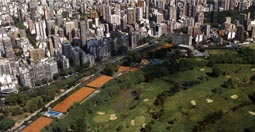Argentina
celebrates 190 years
of independence
Message from HE
Carlos Faustino Garcia Ambassador from The Republic of Argentina
|
Today
the people of Argentina commemorate the 190th anniversary of its
independence from Spain in 1810 and the setting of the first self
governing institution in the country.
Argentina
is a Republic with an extremely rich territory of 3 million square
kilometres, with a presidential system and a bicameral parliament.
The newly
elected president of The Republic is Dr. Fernando De La Rua. Its
population has grown to almost 40 million inhabitants.
The
Diplomatic relationship with the Kingdom of Thailand, including the
commercial and trade aspects, is in an excellent situation. This year we
are celebrating the 45th anniversary of establishing those diplomatic
bonds between the two nations.
Though
geography has put both countries far away from one another, cultural and
political activities are in progress all the time. Thus former President
Carlos S. Menem has visited the Kingdom and so did too in Argentina
H.R.H. The Crown Prince Maha Vajiralongkorn during 1994 and Princess
Chulabhorn and Princess Galyani Vadhana more recently this year.
I would like to remark
that the celebration of Argentina’s National Day is a good occasion to
express our sincere appreciation to the Thai people, being sure that the
strong friendship between our two countries will continue to grow firmly
into this millennium, working together for international peace and the
development of our national communities.
|
|
Argentina - A Few
Facts
May
25 marks the 190th anniversary of Argentina’s independence from Spain in 1810
and the setting of the first self governing institution in the country. The head
of Government sits in the Capital of Buenos Aires in which it is also estimated
that almost half the population of country resides.
 The
Capital, Buenos Aires
The
Capital, Buenos Aires
Argentina is
located on the South American Continent; it is the second largest country (next
to Brazil) and borders with Uruguay, Brazil, Paraguay, Bolivia and Chile as well
as a significant coastline along the Atlantic Ocean.
The name
Argentina comes from the Latin argentum which means silver. The origin of the
name goes back to the voyages made by the first Spanish conquistadors to the Rio
de la Plata. The shipwrecked survivors of the expedition mounted by Juan Diaz de
Solis discovered Indians in the region who presented them with silver objects.
The news about the legendary Sierra del Plata, a mountain rich in silver,
reached Spain around 1524. From this date the Portuguese named the river of
Solis, the Silver River (Rio de la Plata). Two years later the Spanish used the
same name. Since 1860 the official name of the country has been the Republica
Argentina (Republic of Argentina).
Argentina
enjoys a vast array of contrast between the immense eastern plains and the
imposing mountain range of the Andes to the west. This is the frontier with
Chile and it has the highest peak in the Western hemisphere: the Aconcagua,
6,959 metres high.
 The
Beauty of the Patagonian Andes
The
Beauty of the Patagonian Andes
In its passage
from Jujuy to Tierra del Fuego the range presents marvellous contrasts, the
plateau of the Northwest, the lake region, the forests and the glaciers of the
Patagonian Andes.
To the north,
Chaco is a forested area which follows the rivers Bermejo, Salado and Pilcomayo.
Between the
Parana and Uruguay, the Mesopotamia of Argentina (the provinces of Entre Rios,
Corrientes and Misiones) is formed by low hills where pools and marshlands show
the ancient courses of these great rivers. Occasionally there are fissures which
provide such spectacular phenomena as the Falls of Iguazu.
 The
spectacular Iguazu Falls
The
spectacular Iguazu Falls
La Pampa, in
the centre of Argentina, is the largest and best known area of plains. It has a
large amount of agriculture and livestock and includes the provinces of Buenos
Aires, La Pampa, the south of Santa Fe and the southeast of Cordoba. Its
landscape is broken to the south by the small mountains of Tandil and La Ventana
and to the west by the Cordoba mountain ranges.
 La
Pampa, the Great Plains
La
Pampa, the Great Plains
Towards the south, from the
Andes to the sea, is the stony plateau of Patagonia, swept by the wind during
most of the year. The Atlantic coast, lined with high cliffs, forms massive
indentations like the Valdes Peninsula, with its unique colonies of marine
animals.

The Valdes Peninsula, with a variety of
marine life, home of almost a million penguins


 The
Capital, Buenos Aires
The
Capital, Buenos Aires The
Beauty of the Patagonian Andes
The
Beauty of the Patagonian Andes The
spectacular Iguazu Falls
The
spectacular Iguazu Falls La
Pampa, the Great Plains
La
Pampa, the Great Plains